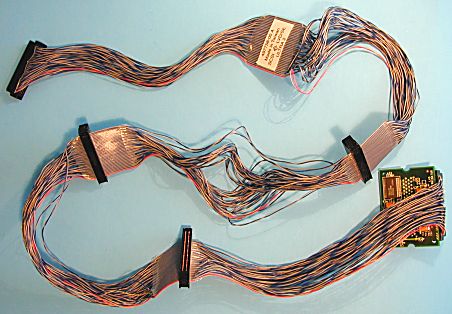[ The PC Guide | Systems and Components Reference Guide | Hard Disk Drives | Hard Disk Interfaces and Configuration | Small Computer Systems Interface (SCSI) | SCSI Cables and Connectors ]
Low Voltage Differential (LVD) Cables, Connectors and Signals
The newest SCSI cables are designed to implement the newest SCSI signaling method, low voltage differential (LVD). Since LVD is a different method of signaling than regular, single-ended (SE) SCSI, the signals used on these cables are quite different than those of SE cables. There are also some differences in terms of the physical cables as well.
First, let's talk about the signals. LVD cables have their signals organized into pairs just like SE cables. However, instead of each pair consisting of a signal and a signal return (ground), each pair consists of the positive and negative complements of the signal. There is also a change to the function of one cable conductor: a special signal called DIFFSENS, which is used to control differential signaling.
Other than these small changes, the signals for LVD narrow cables are the same as for SE narrow cables, and the signals for LVD wide cables are the same as for SE wide cables. Rather than repeat two large tables full of signals with nearly-identical versions, I would refer you to the tables for narrow and wide cables respectively. As you look at those tables, remember that for LVD, each "SIGNAL RETURN" is replaced with the "positive" complement of the active-low regular signal. So for example, cable conductor #15 for an LVD "A" cable carries the signal "+DB(7)", and cable conductor #57 for an LVD "P" cable carries the signal "+REQ". For narrow ("A") cables, DIFFSENS replaces one ground signal on cable conductor #21; for wide ("P") cables it is cable conductor #31.
![]() Note: I should point out
that I mention narrow LVD cables primarily for "completeness"--they are defined
in the SCSI standards but have never been widely used. LVD is generally only implemented
for wide devices.
Note: I should point out
that I mention narrow LVD cables primarily for "completeness"--they are defined
in the SCSI standards but have never been widely used. LVD is generally only implemented
for wide devices.
The physical cables used for LVD SCSI chains are also different from single-ended cables, despite the fact that the connectors used are the same for single-ended. This is really a different matter than the changes in signaling; since the wires don't know what signals they are carrying, in theory one should be able to use the same cables for LVD as for SE. In practice, however, the greater demands placed by the high speed used in LVD signaling means that problems can occur if you try to use SE cables for LVD implementations.
|
An internal, 68-wire, 5-connector LVD cable. Note the |
For external cables, you want to use cabling that is specifically rated for LVD use; these cables have been designed and tested for LVD applications, even if they look the same as their single-ended cousins. As with regular wide cables, they may be found with either high density or very high density connectors. Internal LVD cables are actually very different from SE cables. The reason is that to improve signal integrity, internal LVD cables typically don't use regular flat ribbon cabling. Instead, they use so-called "Twist-N-Flat" cabling, where adjacent pairs of wires are twisted between the connectors, and the wires "flatten out" where the connectors attach. See the discussion of cabling types for more on this kind of wiring.
|
Detail of the cable pictured above, showing one of the
high density |
![]() Next: Single Connector Attachment (SCA, SCA-2)
Next: Single Connector Attachment (SCA, SCA-2)
| The PC Guide
(http://www.PCGuide.com) Site Version: 2.2.0 - Version Date: April 17, 2001 © Copyright 1997-2004 Charles M. Kozierok. All Rights Reserved. |
Not responsible for any loss resulting from the use of this site. Please read the Site Guide before using this material. |

